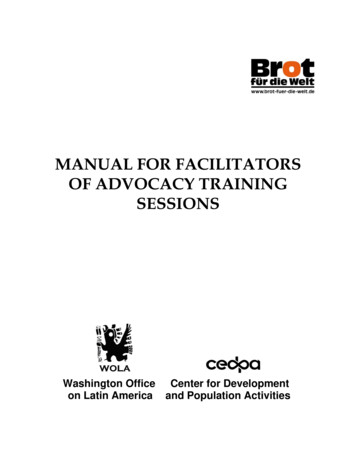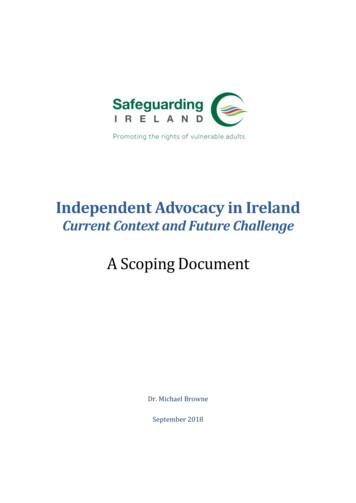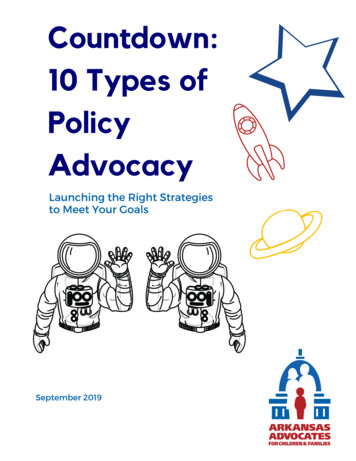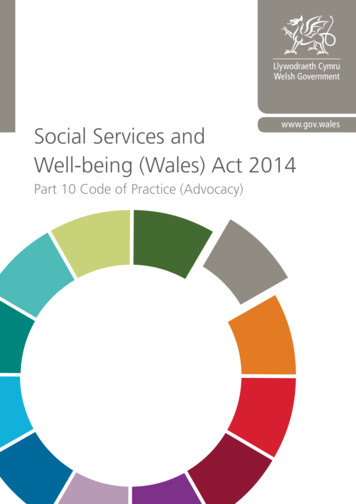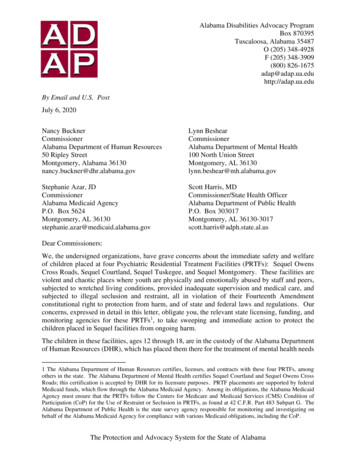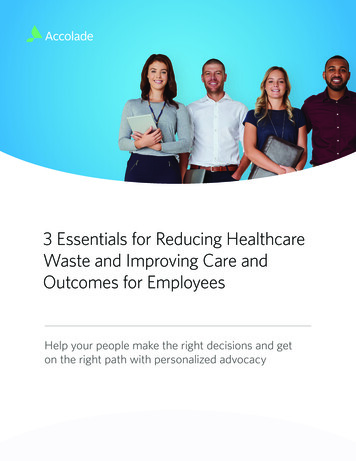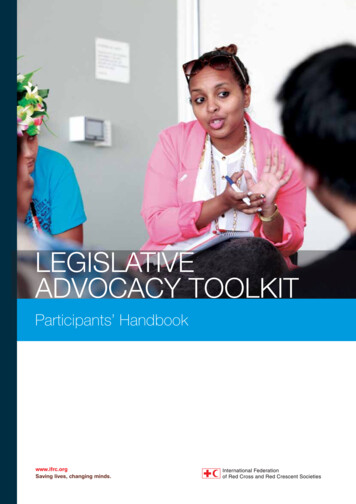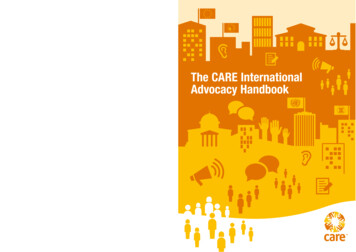
Transcription
THE CARE INTERNATIONAL ADVOCACY HANDBOOK
Published by CARE International May 2014 CARE International 2014CARE International SecretariatChemin de Balexert 7-91219 ChatelaineGenevaSwitzerlandTel: 41 22 795 10 20www.careinternational.orgThis manual has been written with the help of Alice Allan CIUK, Martha Chouchena Rojas CI Secretariat, Margie Lauter CARE USA, SarahLynch CARE USA , Celine Mias CARE Brussels, Aisha Rahamatali CI Secretariat and Sofia Sprechman CI Secretariat. It has been reviewedby CARE’s Advocacy and Media Committee and colleagues with expertise on gender and governance. It has been piloted in a variety oftrainings with colleagues from 13 different country offices.Cover illustration: Dilhan Attanayake. Design: Richard Reeve. Printing: Solopress.
Contents1. Introduction1What is advocacy?1Why advocate at CARE?2How advocacy fits into CARE’s theory ofsocial change42. T he advocacy planning andimplementation cycle6STEP 1 The problem8Case Studies1. SWASH Sustaining and Scaling School Water,Sanitation and Hygiene Plus Community Impact6STEP 12. SWASH How the Problem Tree helped93. Working with the women’s rights movement inLatin America9STEP 24. SWASH Why SWASH maintained anexternal focus115. International politics and women’s rights11STEP 2 The external context10STEP 3 Defining the goal12STEP 4 Who can make the change?16STEP 5 Policy asks and core messages24STEP 6 Resources26STEP 4STEP 7 Action plan andimplementation2910. National to Global Advocacy inAfghanistan18STEP 8 Monitoring and evaluation11. Working with secondary targets183512. Advocacy in an insecure environment –taking a back seat183. M anaging risk, ensuringconsistency3913. Taking the lead: the Child NutritionInitiative in Peru1814. SWASH Taking the insider track1815. Shaping the next set of UNDevelopment Goals2016. Shaping Climate Change Adaptation Funds2117. Influencing the EU on emergencies2218. The International Conference of theGreat Lakes Region23Appendix: Online resources43STEP 36. Food aid reform127. Shaping a G8 agenda158. Linking savings groups to banks159. SWASH goals15
ToolsSTEP 519. CARE counts the cost of violenceagainst women in Bangladesh2520. Establishing new banking principles withthe private sector2621. SWASH How policy objectives led toconcrete change26STEP 61. Problem Tree92. PESTLE analysis103. Objectives Tree134. Testing the rationale: Theories of Change145. Helping to prioritise – criteria analysis156. Stakeholder mapping1722. GLAI: funding for a regional initiative287. Communicating for influence2423. Seeking national government fundsin Bangladesh288. Planning effective research for advocacyand campaigning30STEP 724. Women, peace and security strategy:outcomes and activities2925. SRMH advocacy strategy: outcomesand activities2926. Syria advocacy strategy2927. Generating evidence from CARE Bangladesh’sSHOUHARDO programme3128. Using social accountability to build evidencein Peru3129. Using data to change how rape is reportedin Uganda3230. Securing a climate change loss anddamage mechanism3231. High profile visits to CARE programmes3332. CARE USA’s Action Networks (CAN)3333. Supporting other CAREs to build theirsupporter network9. CI advocacy M&E framework3610. Revised advocacy logic model37IllustrationsThe Three Key Elements Of Effective Advocacy3CARE’s Inclusive Governance Model5The Advocacy Planning And Implementation Cycle7Tool 1: The Problem Tree8Tool 2: Pestle Analysis10Tool 3: The Objectives Tree13Tool 6: Stakeholder Mapping17How CARE Can Link Its Local-National-GlobalAdvocacy19Tool 7: Communicating For Influence2433Tool 8: Planning Effective Research ForAdvocacy And Campaigning3034. Supporting southern voices forclimate change34Tool 9: CI Advocacy Monitoring AndEvaluation Framework3935. Social media: campaigning to endchild marriage35Tool 10: CARE USA Learning Tours: RevisitedAdvocacy Logic Model37Lynn Woolsey’s Champion-ness over time38STEP 836. SWASH How SWASH used flexiblelearning to aid M&E38Tables37. The learning tour scorecard38Tool 5: Criteria analysis1438. Peru scorecards38Killer facts25Approval processes41Risk mitigation42
1. Introduction“CARE’s primary asset in the fight against poverty isthe knowledge, ideas, and experience gained throughits implementation of coherent programs that drawon rights-based perspectives and gender analysis; thestrong connections within and across CARE and poor andmarginalised communities, social movements, governments,civil society, academia, the private sector, foundations,and individuals (both activists and donors), and its strongcapacity for ‘local-to-global’ advocacy.” CARE 2020.Advocacy is integral to delivering CARE’s vision. Thismanual is a toolkit of approaches, techniques andadditional resources to help CARE staff think about howto integrate advocacy into their work. It has been updatedfrom its original 2001 version to take into account variousdevelopments in CARE, such as the programme approachand the focus on women and girls. It also recognises thatCARE now works in a range of contexts, from fragile tomiddle income states, and with new actors. The manual isstructured around an eight-step advocacy planning cycleand could be used to plan an initiative from start to finishor dipped into at any point during the process. It is keyto remember that advocacy is not a linear process but amore complex one where plans have to be adapted whencontexts change.What is advocacy?Often national and international policies to protect poorand marginalised communities are absent, ineffective ornot implemented. CARE’s definition of advocacy recognisesthis and is as follows:Advocacy is the deliberate process of influencing thosewho make decisions about developing, changing andimplementing policies [in CARE’s case: to reduce povertyand achieve social justice]. CARE’s advocacy might be focused on issues in thepublic (e.g. public service provision) or private (e.g.the rights of domestic workers in the home, or garmentworkers in factories) sphere. CARE and many otherorganisations have long argued for ‘private’ issues,such as female genital cutting, to become issues ofpublic concern. Often the people we are working with interact mostly inthe ‘informal’ sector or space. Part of our role as CAREis to facilitate or build bridges between people living inpoverty and ‘formal’ institutions (e.g. local authoritiesand national government, parliaments, donors). Therole of being a convener is, in fact, a central one forpromoting dialogue resulting in pro-poor policies. At CARE, advocacy is the means by which we choose toinfluence decision-makers, or the tactics, while policy isthe content, or the ask, the ‘what we want to change’.One cannot be done without the other. Advocacy and policy at CARE are targeted at powerholders above the household level.Advocacy at CARE: key termsWhat does ‘influencing’ look like?Advocacy is about influencing those who make policydecisions. Decision-makers are generally those who havethe ability to legislate, negotiate or set budgets relatingto formal public policies (e.g. district and municipalofficers, national civil servants, parliamentarians,ministers in national governments and internationalinstitutions such as the United Nations (UN)). Decisionmakers are not necessarily always the ‘power holders.’Their decisions can often be heavily influenced by thosewho hold formal and informal power in society includingbusiness, the media, religious leaders, and socialmovements amongst others. There are many ways toinfluence decision-makers and power holders, includingoutsider tactics of confrontation and public mobilisation,to insider tactics of lobbying behind the scenes. Advocacycan be done alone or in coalition. There is no one size fitsall approach; each context will require different tactics.What does ‘deliberate process’ mean?Advocacy is a deliberate process, involving intentionalactions. Therefore, before implementing advocacy strategies,it is important to be clear who the strategy is trying toinfluence and which policy it is attempting to change.What does ‘developing, changing andimplementing policies’ mean?Often policies are outdated or non-existent, ordeliberately block what we want to achieve, so legislative1
The CARE International Advocacy Handbook Introductionchanges are required. In other cases policies are perfecton paper but are not being implemented. In this instanceadvocacy might focus more on trying to get policiesenacted. For example, in many countries there are nowvarious provisions for gender equality under the law;however this does not necessarily mean that access toland titles for women is becoming easier. In this case,an intervention might mean partnering with a legal NGOto force implementation of the legislation through thecourts. It could also involve partnering with a nationalradio station to raise awareness of non-implementationand encourage national debate.What advocacy is notExtension workEncouraging households to change their agricultural orhealth practices is an important programming strategyused in many CARE programmes. However, extension workis designed to influence individual decisions made at thehousehold level, not the behaviour or decisions of policymakers that affect many households.Information and communicationAdvocacy intends to change or implement a policyissue. It will always need to be supported by tacticalcommunications (e.g. strong key messages andrelationships with influential journalists that powerholders take notice of). Advocacy messages can have thebeneficial effect of raising public awareness of CARE’swork. However, general communications, e.g. case studiesand photographs of projects, do not count as advocacy.Our vision and mission acknowledge that innovativesolutions will be needed to end poverty, and thatinfluencing policy decisions should be part of our effortsto achieve lasting change. As set out in the programmeapproach, advocacy can be a powerful, complementarytool to other strategies, including service delivery,capacity-building, and technical assistance. As a rights-based organisation that seeks to focus onthe underlying causes of poverty (which are frequentlyrelated to an absence or poor implementationof policies), advocacy can help us achieve moresustainable outcomes. Advocacy can shape futurenational, international, donor and private sectorpriorities, e.g. gender standards for emergencyresponse. Advocacy helps us to respond to developmentthreats and opportunities (e.g. cuts to national aidbudgets, restrictive NGO laws, or supporting a new UNdevelopment goal on gender). Advocacy with multilateral organisations like the UNand the European Union (EU) can help set standards ortargets which can then be used to hold governmentsacross the globe to account, e.g. the Convention on theElimination of Discrimination Against Women, or theMillennium Development Goals (MDGs). Advocacy can amplify the voices of women and otherpoor and marginalised communities by ensuring theirvoices are heard by power holders.Building good relationships with decision-makers is animportant way to lay the foundation for advocacy andbuild credibility. However, advocacy is not just aboutinforming the government about CARE’s programmes.In advocacy, information-sharing is used as a deliberatestrategy to influence specific decisions of policy-makers. Advocacy is about accountability. Those who havepower, including governments should deliver oncommitments made to their citizens, and businessshould deliver on their commitments to customersand the communities in which they operate. When thisdoesn’t happen citizens can use advocacy to ensurepower holders are accountable.FundraisingWhat change can advocacy bring about?Informing the government about CAREThe primary purpose of advocacy is not to increase CARE’sfunds. Some advocacy may involve asking policy-makersto allocate more resources for relief and developmentpriorities, and sometimes this may benefit CARE.Additionally strong insider advocacy can position CARE toshape donor priorities. More often, however, it involvestrying to influence a governmental agenda, corporatebehaviour, a specific public policy, or the implementationof a policy.2Why advocate at CARE?This manual captures a number of CARE’s national andinternational advocacy efforts including: Scaling up water and sanitation in schools across Kenyato reach 20,000 children and a doubling of annualbudgets for water and sanitation in schools. Lobbying for an International Mechanism for Loss andDamage to address the pace and severity of the impactsof climate change that can no longer be addressed byadaptation and mitigation.
Policy influencing can help shapeand access funding opportunities Policy influencing helps us to respond todevelopment threats and opportunities(eg cuts to 0.7% GDP on aid or supportinga new MDG on gender)those you want to influence. This is a usefultest to use when assessing what to advocatefor, when, who with, and how.The CARE International Advocacy Handbook IntroductionThe Three Key Elements Of Effective AdvocacyPoliticsGOODADVOCACYGOOD POLICYDo-abilityEvidenceFigure3: theto“ingredients”of goodlegislationpolicy-making Helpingbring about nationalto combatviolence against women in Bangladesh, by quantifyingits cost to the national economy.launched in Cape Town on December 10, 1998. It built agrassroots movement that went on to support and opposethe South African government, harass drug companies,educate the population, and challenge internationalIn recent years there have also been a number ofpolicy. Once President Jacob Zuma came to power, thePolicy making into Practice at care international5international advocacy campaigns led by others thatPuttinghaveSouth African government ultimately transformed itssought to tackle some of the underlying causes of poverty,policies toward HIV/AIDS treatment, and now 1.2 millionwhich are worth considering. They include:South Africans are on anti-retrovirals (ARVs).The International Campaign to Ban Landmines (ICBL)EXTERNAL TOOLbegan in 1991. Initiated by a small group of like-mindedThese examples are adapted from Brendan Cox, ‘Campaigning fororganisations (first by Medico and Vietnam Veterans ofInternational Justice’ 1991–2011, May 2011America Foundation, then quickly joined by HandicapInternational and Mine Action Group, and later HumanWhat makes advocacy effective?Rights Watch the campaign quickly grew into a diverseThe three key ingredients of advocacy and policy-makingcoalition across almost 100 countries. The campaignare the politics, the evidence and the ‘do-ability’. CARE’scontinued to ensure monitoring and implementationexpertise is in pulling together a strong evidence baseuntil 2010, by which time there were more than 150 stateto underpin our advocacy. However evidence on its ownparties to the treaty.does not achieve advocacy impacts (nor does the evidenceJubilee 2000 was an international campaign to abolishthe debts of poor countries by the year 2000. Emergingin 1997 from the UK Debt Crisis Network, it quicklygained momentum. The UK coalition was organised by astrong secretariat, which also facilitated the loose globalcoalition. Focusing on the G8s in 1998 (Birmingham) and1999 (Cologne,) the campaign mobilised faith activistsbut also a wider audience. The campaign culminated in the1999 debt relief deal in Cologne, which saw the clearanceof an extra 27bn of developing country debt.have to come from CARE). The evidence needs to signpostpolicy-makers towards achievable policy solutions – i.e.be clear about the ‘do-ability’ of what CARE is advocatingfor. Finally, the political context is key. For example,there is no point lobbying a government for an increasein spending for a particular service near to a generalelection, as they will not be in a position to commit newfunds; instead, consider how to incorporate the ask into amanifesto commitment of the main political parties.The Treatment Action Campaign (TAC), which workstoward universal access to treatment for HIV/AIDS, was3
The CARE International Advocacy Handbook IntroductionKey conditions for a successful advocacy campaign Functioning venue(s) for adoption: the relevant legislative,legal, and regulatory institutions are functioningsufficiently for advocacy to be effective. Open policy window: external events or trends spur demandfor the solution. Feasible solution: a feasible solution has been developedand shown to produce the intended benefits. Dynamic master plan: a pragmatic and flexible advocacystrategy and communications plan is ready for execution. Strong campaign leader(s): central advocates can assembleand lead the resources to execute the strategy andcommunications plan. Influential support coalition: allies can sway neededdecision-makers and help the campaign leader to pursuethe solution. Mobilised public: relevant public audiences activelysupport the solution and its underlying social principles. Powerful inside champions: decision-makers who canovercome the opposition support the solution and itsunderlying principles. Clear implementation path: the implementing institutionhas the commitment and the ability to execute thesolution.(From www.redstonestrategy.com)How advocacy fits into CARE’stheory of social changeAdvocacy is well integrated in our CARE 2020 ProgramStrategy. The Strategy is based on CARE’s wealth ofexperience gathered from 70 years of poverty-fightingwork, our analysis of the strategies that drive positivesocial change, and our full commitment to addressing themost important factors inhibiting the fulfillment of rights– especially those of women and girls.CARE’s draft program strategy clearly states that at itsroot, poverty is caused by unequal power relations thatresult in the inequitable distribution of resources andopportunities between women and men, between powerholders and marginalized communities, and betweencountries. CARE believes that poverty cannot be overcomewithout addressing those underlying power imbalances.Advocacy plays a key role in addressing this injustice.More specifically, the draft CARE 2020 program strategy1proposes three central roles for catalysing social change: Humanitarian action. In emergencies, we respond tosave lives, with special attention to the needs of womenand the most marginalized. Our humanitarian actionincludes preparedness and early action, emergencyresponse and recovery, and encourages future resilienceand equitable development. Action to reduce impactsand risks and to secure gains in development andequality must be increasingly CARE’s focus given thegrowing magnitude, severity and number of disasters Promoting innovative solutions for sustainabledevelopment. Our programs trigger innovativesolutions through essential service delivery, buildingcapacities, building resilience for reducing risk,and empowering the most vulnerable, particularlywomen and girls. They are based on a deep, historicalunderstanding of the drivers of poverty and socialinjustice in a particular context and tailored to theneeds of the most marginalized. We have a special focusin the areas of sexual, reproductive and maternal health(SRMH) and freedom from violence; food and nutritionsecurity; and women’s economic empowerment. Theevidence and learning from these programs is essentialfor our third role, which amplifies our impact. Multiplying impact. All our work seeks to impactin and beyond the communities in which we directlywork. We use the evidence and learning from ourhumanitarian action and long-term developmentprograms to influence broader social change. It isthrough this role that CARE can contribute to deeperand sustainable impact by documenting successfulmodels, leveraging knowledge, advocating forreplication and expansion of proven approaches,promoting pro-poor solutions, influencing powerholders at all levels to change their policies andpractices, and convening and brokering linkagesbetween actors.Advocacy is one of the most important strategies formultiplying CARE’s impact beyond the communities inwhich we directly work. It is an essential strategy thatcomplements others.Also if power imbalances are at the root of poverty, then itis key to consider how advocacy can support moreinclusive governance. What does inclusive governancemean? Governance is about the exercise of power in themanagement of public affairs. We believe that if citizensare empowered, if power holders are effective, accountable1. The draft program strategy will be presented to the CI Board forapproval in June 2014.4
The CARE International Advocacy Handbook IntroductionCARE’s Inclusive Governance ModelSUSTAINABLEDEVELOPMENTWITH EQUITYEXPANDED, INCLUSIVE &EFFECTIVE SPACESFOR NEGOTIATIONEMPOWEREDCITIZENSACCOUNTABLE &EFFECTIVE PUBLICAUTHORITIES ANDOTHER POWER HOLDERSand responsive, and if spaces for negotiation are expanded,effective and inclusive, then sustainable and equitabledevelopment can be achieved. Significant change isneeded in all three areas to achieve sustainable impact.Advocacy is central to delivering each of the threecomponents of social change.1. In supporting the empowerment of citizens,especially of marginalised women and girls, the aimis to enable them to become active and demandtheir rights. This can be achieved through workingin coalition with and strengthening the advocacycapacities of organisations and movementsrepresenting marginalised women and girls. CARE aimsto be a supportive and empowering partner of suchmovements, learning from them as well as sharingour global capacity, experience and ability to workat global, regional, national and local levels. CAREmight also support advocacy campaigns that tacklethe structures and relations that can inhibit women’sability to actively participate in demanding rights, e.g.campaigning for better wages and flexible workingconditions for women.and brokering relationships to ensure that theinterests of poor and marginalised communities areserved and that resources are allocated on a moretransparent, accountable and equitable basis. Thisinteraction needs to happen at local, national andinternational levels. In CARE our programmes oftenaddress the interaction between poor and marginalisedcommunities and local authorities. CARE also workswith communities and informal leaders, includingreligious leaders, to begin to transform social normsor practices that harm women. Advocacy can help tobridge the interaction at national and internationallevels, for example by facilitating dialogue betweennational coalitions and government ministers, or bysupporting activists to attend internationalconferences to voice their concerns at the UN.Whilst advocacy and inclusive governance efforts aretargeted above household levels, CARE’s overall approachto social change recognises that significant changes inpower relations are also required at household levels. Asan organisation that is committed to achieving genderequality and women’s empowerment CARE seeks toincrease women’s individual agency AND change structuralbarriers in order to shift social and cultural norms,policies and key relationships in ways that allow womenand men to step into new roles. CARE’s advocacy can oftencontribute to addressing the structures, relations andagency of women above household levels.This manual encourages the use of gender analysisthroughout – both when developing advocacy goals andstrategies and as part of risk mitigation.Furthermore, gender equality movements and impactgroups should be considered core stakeholders andwherever possible be engaged in defining advocacy goalsand strategies. This will help make sure CARE’s workadds to, rather than detracts from or duplicates existingmovements.2. Advocacy is central to making power holders moreeffective, accountable and responsive to citizensliving in poverty, and in particular to excluded womenand girls. If public authorities and other powerholders (such as the private sector) are accountablethen people living in poverty will have access tobetter quality services and other public goods (andsometimes private sector goods such as decent wages).3. Finally, advocacy can help to promote the interactionbetween empowered citizens and decision-makersby expanding formal and informal spaces for dialogue5
2. T he advocacy planning andimplementation cycleThe diagram opposite represents the eight-step planningcycle which should be applied when designing andimplementing an advocacy strategy.It represents an ideal process where a programme orcampaign integrates advocacy from the start (as theSWASH example we have included throughout thismanual shows).Often CARE undertakes advocacy to react to opportunitiesand challenges – e.g. advocating for stand-alone gendergoals in the post-2015 MDG process, defending nationalaid budgets in the UK or US, or protecting remittanceflows to Somalia. In these instances the cycle is stillappropriate but needs to be accelerated. Less time mightbe spent on identifying the problem but more on definingpolicy asks and messages, or undertaking research tobuild up the evidence.Time and resource constraints – such as the difficulty ofgetting key actors together to plan effectively – meanit is sometimes tempting to start at Step 7: Action planand implementation. However, skipping key steps suchas understanding the context and defining policy askscan seriously undermine the effectiveness of the wholestrategy.Finally, the steps are all clearly interlinked. Indeed, Steps3 and 5 may appear to be the same thing. However the‘goal’ (Step 3) should be the ambitious vision for changewhile the policy ask (Step 5) needs to be the practicalpolicy change that the power holders and the context willallow at a particular moment in time.The cycle should be consistently reviewed based on regularmonitoring and evaluation of results, and of the politicalcontext.This manual includes multiple CARE examples of advocacyto help illustrate different steps of the cycle. It alsoincludes a case study on SWASH , a water and sanitationprogramme that was scaled up across Kenya. This casestudy followed the entire advocacy planning cycle and isused throughout the manual to illustrate all eight steps.6CASE STUDY 1: SWASH Sustaining and scaling school water, sanitation andhygiene plus community impactInadequate water and access to sanitation in schools ispart of the larger global water and sanitation crisis. TheSWASH programme has worked to achieve sustainable andnational-scale school water, sanitation and hygiene (WASH)in Kenya through applied research and advocacy. A learningpilot in 200 primary schools has since contributed to changein 20,000 schools nationally and the Kenyan Ministry ofEducation has doubled the yearly budget for water andsanitation in primary schools.SWASH is a five-year programme funded by the Bill andMelinda Gates Foundation and includes CARE, EmoryUniversity’s Center for Global Safe Water, and Water.org.The research and advocacy efforts focused on improvingbudgeting for operations and maintenance costs, improvingaccountability systems with a focus on monitoring andevaluation, and more effectively promoting knowledge ofWASH through teacher training and the national curriculum.Advocacy objectives were developed through Problem Treeand stakeholder analyses. SWASH used outcome mappingto track progress against these objectives. Specific advocacygoals were to identify important policy intervention areas,work with policy-makers to update knowledge and identifylearning gaps and then act as learning advisers to therelevant ministries.Lessons learned include:1. Having a rigorous evidence base creates credibility withpolicy-makers.2. Significant time and follow-up are needed as well ashaving staff with appropriate skills.3. The ‘ripeness’ of the external policy environment iscrucial and can make or break efforts to affect nationalscale change. Successful advocacy initiatives avoid beinginsular, focus on the external policy environment at theoutset, assess data needs and stakeholder roles andresponsibilities, and set reasonable objectives.
The CARE International Advocacy Handbook IntroductionThe Advocacy Planning And Implementation Cycle12What is the problemwe need to solve?Identifying theissue.What is happening inthe external context?83How will we monitorand evaluate ourprogress?What has to change?Defining the goal.IMPLEMENTATION7What is our planof action andimplementation?6What resourcesdo we have?4Who can make thechange? What rolecan CARE play?5What are our policyasks and coremessages?7
The CARE International Advocacy Handbook The advocacy planning and implementation cyclein Latin America – see case study. During an emergency,impediments to humanitarian access or lack of donorfunding present themselves as immediate problems.STEP 1The problemThe first step is to identify the policy-related problemthat needs to be solved and its underlying causes – forexample, policies might be absent, ineffective or notenforced.Sometimes policy issues can be identified easily basedon programme experience, e.g. a community scorecardprocess about a particular local service might highlightwider national budgeting problems. In other cases localcivil society might be calling for changes to nationallegislation on domestic violence and request CAREsupport. CARE might also take proactive steps to identifyproblems and understand our added value (as happenedwhen CARE supported the domestic workers movementHowever it is best not to assume complete understandingof a problem as this can lead to ineffective advocacy.Using tools like the Problem Tree (see below) or Theoriesof Change will save time in the long run.TOOL 1: The Problem TreeProblem Trees help find solutions by mapping out theanatomy of cause and effect around an issue in a similarway to a Mind Map, but with more structure. This bringsseveral advantages: There is more understanding of the problem and itssometimes interconnected and
At CARE, advocacy is the means by which we choose to influence decision-makers, or the tactics, while policy is the content, or the ask, the 'what we want to change'. One cannot be done without the other. Advocacy and policy at CARE are targeted at power-holders above the household level. Advocacy at CARE: key terms


